

Our test system listed 'IPVanish VPN (L2TP)' and 'IPVanish VPN (PPTP)', for instance, clearly left over from a previous IPVanish installation. These only list basic L2TP and PPTP connections, and as most VPNs use OpenVPN there's a chance you'll see nothing at all. (If you're on an earlier version of Windows, you can also view your network profiles from the Control Panel 'Internet Options' applet.)Ĭlick VPN in the left-hand pane to view any VPN profiles.
Uninstall vpn unlimited windows#
On Windows 10, press Win+I to open the Settings dialog and click 'Network & Internet'. The privacy impact of this is small, but it could allow snoopers to see which VPNs you've used and when, months or even years after any client was uninstalled. Windows maintains profiles of some of the networks you access, optionally including your logon details, making it easier to reconnect later. (Image credit: Microsoft) Windows network profiles Don't delete anything that references 'System' or 'SystemRoot' in the Program column, and don't touch anything else unless you're entirely sure it's safe to do so. Making a mistake here could weaken your security or cause all kinds of odd problems.

But as the clients had been removed, they weren't necessary anymore, so we deleted them in just a few clicks.īe careful. They were very simple – merely having been set up to allow the client executables to get through the firewall – and they weren't causing any problems.

We found leftover rules for Norton Secure VPN, PureVPN, SlickVPN, Trust.Zone and VPN Unlimited. If you find a rule relating to a VPN (or any other application) you've uninstalled, and its program file no longer exists, then you can safely remove it by right-clicking and selecting Delete.Ĭlick 'Outbound Rules' and repeat the process. Launch the 'Windows Firewall with Advanced Security' applet to find out more (press Win+R, type wf.msc and press Enter.)Ĭlick 'Inbound Rules' in the left-hand sidebar and browse down the list. Usually this scheme works well, but the problem is these rules aren't always removed, cluttering the list and maybe leading to unpredictable network issues later. Typically this is just to ensure they always get access to the outside world, but occasionally they'll also use the firewall to control particular types of traffic. Some VPNs add custom rules to the Windows firewall.


 0 kommentar(er)
0 kommentar(er)
